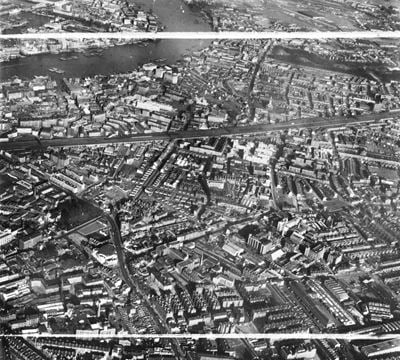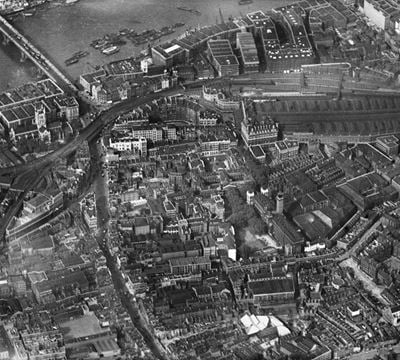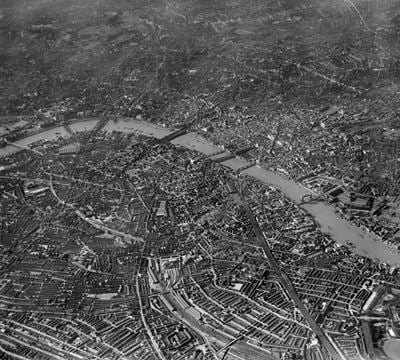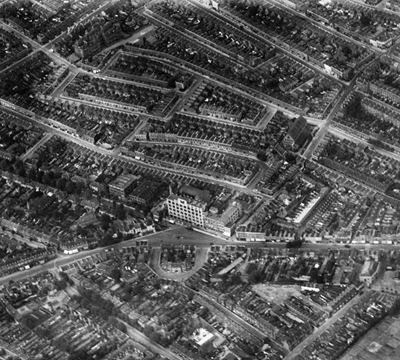Southwark
Explore hidden histories, historic photos, and things you never knew about Southwark from the collections and archives of Historic England.
Discover your local listed buildings and places
Introducing some of Southwark's most historic sites, included in the National Heritage List for England. Some of these captions have been summarised by AI. Click through for the official List entry. Skip this section and go to place by numbers
Swedish Seamen's Mission
Southwark
Seamen's mission and church, 1964-66 by Bent Jörgen Jörgensen with Elkington Smithers, incorporating a church of 1930 by Wigglesworth and Marshall Mackenzie.
Roman Catholic Church of the Most Precious Blood, Presbyt…
Southwark
Church and presbytery of 1891-92 designed by F A Walters. The church is in neo- Romanesque style, the presbytery in Arts and Crafts style.
The Circle
Southwark
Mixed-use residential development with offices and commercial units, 1987-1989 by CZWG (Campbell Zogolovitch Wilkinson and Gough).
Roman Catholic Church of The Most Holy Trinity
Southwark
Roman Catholic church, built in 1957-60 from designs by H S Goodhart-Rendel.
Former David Greig shop at 65 Lordship Lane
Southwark
A late-C19 shop front and ground floor interior, fitted out for the David Greig chain of grocery stores. The upper storeys are not included in the listing.
Former Sons of Temperance Friendly Society Building
Southwark
Friendly society headquarters, now offices, 1909-10 by AC Russell.
Swedish Quays, 1-95 Rope Street
Southwark
A complex of 95 flats and houses of 1986-1990 by David Price and Gordon Cullen for Roger Malcolm Homes, in two courtyard phases of near-symmetrical design.
Metro Central Heights
Southwark
Former offices for the Ministry of Health, designed by Ernö Goldfinger RA. Built in two phases, Blocks A-C (1959-62); Block D (1964-66). Converted into housing 2002.
The Roebuck Public House
Southwark
Public house, late C19, by an unknown architect. Later alterations, mainly to the interior.
Gasholder No.13, Old Kent Road former gasworks
Southwark
Gasholder. Built in 1879-1881 by the engineer George Livesey and contractors Ashmore & While for the South Metropolitan Gas Company. The tank was constructed by Dowcra & Sons.
Kirkaldy's testing works and testing machine
Southwark
Former materials testing works. Designed by Thomas Roger Smith for David Kirkaldy in 1873. The building contains his hydraulic testing machine of 1863-4 for which it was purpose built.
Nunhead Cemetery (All Saints)
Southwark
On Rocque's map of 1746 the future site of Nunhead Cemetery is shown as farmland.
22 Shad Thames
Southwark
Offices and showroom (originally with a penthouse flat). Built 1988-1991 for the designer and manufacturer David Mellor to designs by Michael Hopkins and Partners.
Burgess Park War Memorial
Southwark
War memorial, unveiled 1920, in the form of a bronze statue of Christ atop a plinth.
Subway, Vestibule, Terrace and Stairs to the Crystal Palace
Southwark
Pedestrian subway, vestibule, terrace and stairs to the Crystal Palace, opened 1865, designed by Charles Barry Junior.
Roman riverboat, 136m west of Greenwood Theatre
Southwark
The Roman riverboat, located near Greenwood Theatre, is a rare and well-preserved archaeological find, offering insights into Roman-era transport and commerce.
Resited Floral Hall Portico at Borough Market
Southwark
Originally a multi-purpose space for hire alongside the Royal Opera House, Covent Garden, now (since being moved to its present site c2003) a decorative frontage to Borough Market with...
The Globe Theatre
Southwark
The Globe Theatre, built in 1599, was linked to Shakespeare and hosted prominent plays and actors like Richard Burbage. It's a key site for theatre history and Shakespeare studies.
Neckinger Mills
Southwark
Former warehouse, 1864, now in mixed residential and commercial use, and associated dwelling house (included for group value). Some late C20 alteration.
Mural depicting the History of Old Kent Road
Southwark
A large ceramic mural consisting of three panels which depict the history of the Old Kent Road, 1965, by Adam Kossowski.
Tabard Street Centre (Former Tabard Street School)
Southwark
School, dated 1873, completed 1874; by Frederick W Roper, for the London School Board; converted to residential flats in 1990s.
Southwark Fire Station
Southwark
Fire station, 1878, by Alfred Mott, chief architect to the Brigade under the Metropolitan Board of Works, and 1911 by the Fire Brigade Branch of the London County Council Architects...
Former Dock Manager's Office and 1-14 Dock Offices
Southwark
Former Dock Offices to Surrey Commercial Docks built in 1893, probably to designs by the engineer, James McConnochie for the Surrey Commercial Dock Company.
54 Borough High Street
Southwark
No. 54 Borough High Street, a house and commercial premises, dating from the early C18, and probably retaining earlier fabric, with significant remodelling of the early and late C19.
Medieval moated manor house, 43m west of Cathay House
Southwark
The medieval moated manor house at Rotherhithe, once a royal residence for Edward III, is historically significant and remains largely preserved, offering insights into medieval aristocratic...
Southwark Park
Southwark
Southwark Park, opened in 1869, was developed on land purchased from Sir William Gomm, with gardens, a lake, and a bandstand added over time.
The Ivy House public house
Southwark
Public house. 1937-1938 designed by AE Sewell for Truman's Brewery.
19, Tabard Street
Southwark
Former hardware merchants' workshop. Built 1891, to the designs of an unknown architect.
Church of St John the Evangelist, with associated walls, …
Southwark
Anglican church in Gothic Revival style, 1859-1860, by Henry Jarvis, with vestry of 1912 by Greenaway and Newberry, with associated walls and railings.
Church of St Peter
Southwark
A Commissioners' church constructed 1823-1825 to designs by Sir John Soane, and restored following Second World War bomb damage 1952-1955 by Thomas Ford.
Pumping engine house for Brunel's Thames tunnel
Southwark
The Pumping Engine House for Brunel's Thames Tunnel is a notable 19th-century monument built by Marc and Isambard Brunel, featuring preserved historical architecture and educational value.
Railway viaduct arches
Southwark
Railway viaduct arches, 1864-6, by Charles Henry Driver for the London, Brighton & South Coast Railway.
Archbishop's House and Cathedral House
Southwark
1886-87 bishop's house and clergy house designed by the architect Frederick A Walters in Gothic style, but incorporating parts of an 1840s clergy house and schools by A W Pugin.
Dulwich Library
Southwark
A Passmore Edwards Library designed by Charles Barry and Son in Elizabethan Revival style and erected 1896-7.
Romano-British bath house and medieval remains at 11-15 B…
Southwark
The monument includes part of a Romano-British bath house and a chalk construction and vaulted chalk piers dated to the C11 to C12.
Explore more
Search for more listed placesSouthwark through time
This timeline shows the first period of use for buildings and places on the National Heritage List for England, just one of the details recorded for every list entry. Click around to see how Southwark changes over time. Skip this section and go to aerial photos
Prehistoric Before AD 43
Prehistory covers a million years of human occupation before the Roman invasion, from hunter-gatherers of several human species, including Neanderthals, to more recent herders and farmers. It was a time of developing technologies and belief systems, involving contact with and migration from Europe, all reflected in the variety of artefact and monument types characteristic of particular prehistoric periods.
Roman AD 43 to AD 410
Britain was invaded by four legions of the Roman army in AD 43, who relatively rapidly conquered England from landing points in Kent. Parts of Wales and Scotland soon followed.
Roman culture brought urbanism, monumental buildings, wide-ranging religious beliefs, writing, and strong social hierarchy. The Roman administrative system was withdrawn in AD 410.
Early medieval AD 410 to AD 1066
This period, often associated in England with Anglo-Saxons and Vikings, saw a reduction in urban living from the Roman period and increased migration from northern Europe.
Traces of this period can be found in cemeteries, particularly in artefacts and in some of the very early churches, as this period also saw the growth of Christianity in Britain.
Medieval AD 1066 to AD 1540
This period, sometimes known as the Middle Ages, began with the Norman invasion in AD 1066. It saw a significant rise in military and defensive buildings such as castles and earthworks, as well as religious houses dominating a largely agricultural landscape.
The monarchy and Church dominated the period, which also saw the break with the Roman Catholic Church and the English reformation.
Post medieval AD 1540 to AD 1901
The Post-Medieval period brought seismic changes to life in England, with religious reformation leading to the democratization of worship and the destruction of hundreds of religious houses.
In parallel, there was a huge expansion of scientific study and enlightenment that permanently altered the nation's social structure and landscape. Industrialization and mass production lead to wider global trade, emigration, and immigration.
20th century AD 1901 to AD 2000
The 20th century saw an incredible expansion of England's transport networks, with suburban growth shadowing rapid infrastructural expansion. The establishment of state schools, hospitals, and modern technical colleges, with new architectural styles, radically changed the appearance of towns and cities.
Two catastrophic world wars and the 1918 pandemic also brought unprecedented change, altering England's built environment and social structures forever.
Prehistoric Before AD 43
Prehistory covers a million years of human occupation before the Roman invasion, from hunter-gatherers of several human species, including Neanderthals, to more recent herders and farmers. It was a time of developing technologies and belief systems, involving contact with and migration from Europe, all reflected in the variety of artefact and monument types characteristic of particular prehistoric periods.
Roman AD 43 to AD 410
Britain was invaded by four legions of the Roman army in AD 43, who relatively rapidly conquered England from landing points in Kent. Parts of Wales and Scotland soon followed.
Roman culture brought urbanism, monumental buildings, wide-ranging religious beliefs, writing, and strong social hierarchy. The Roman administrative system was withdrawn in AD 410.
Early medieval AD 410 to AD 1066
This period, often associated in England with Anglo-Saxons and Vikings, saw a reduction in urban living from the Roman period and increased migration from northern Europe.
Traces of this period can be found in cemeteries, particularly in artefacts and in some of the very early churches, as this period also saw the growth of Christianity in Britain.
Medieval AD 1066 to AD 1540
This period, sometimes known as the Middle Ages, began with the Norman invasion in AD 1066. It saw a significant rise in military and defensive buildings such as castles and earthworks, as well as religious houses dominating a largely agricultural landscape.
The monarchy and Church dominated the period, which also saw the break with the Roman Catholic Church and the English reformation.
Post medieval AD 1540 to AD 1901
The Post-Medieval period brought seismic changes to life in England, with religious reformation leading to the democratization of worship and the destruction of hundreds of religious houses.
In parallel, there was a huge expansion of scientific study and enlightenment that permanently altered the nation's social structure and landscape. Industrialization and mass production lead to wider global trade, emigration, and immigration.
20th century AD 1901 to AD 2000
The 20th century saw an incredible expansion of England's transport networks, with suburban growth shadowing rapid infrastructural expansion. The establishment of state schools, hospitals, and modern technical colleges, with new architectural styles, radically changed the appearance of towns and cities.
Two catastrophic world wars and the 1918 pandemic also brought unprecedented change, altering England's built environment and social structures forever.
Aerial photos of Southwark
Aerial photography helps reveal secrets of England's changing landscapes that are impossible to see from the ground. Skip this section and go to archive images

London
Lambeth, Bermondsey and the River Thames from Westminster Bridge to London Bridge, London, 1939

The Borough
Bankside Power Station under construction and the surrounding area, The Borough, 1952

Bermondsey
A cityscape over Bermondsey looking towards Southwark Park, Bermondsey, 1937

Bermondsey
Grange Road and environs, Bermondsey, 1952

Newington
The Waygood Otis Engineering Works, Newington, 1922

Newington
Great Dover Street and environs, Newington, 1949

The Borough
Guy's Hospital and environs, The Borough, 1924

London
Lambeth, Bermondsey and the River Thames from Westminster Bridge to Tower Bridge, London, 1939

Camberwell
Wells Crescent and environs, Camberwell, 1924

Camberwell
Brunswick Park, Southampton Way and the surrounding residential area, Camberwell, 1924
Southwark in the Historic England Archive
The Historic England Archive cares for over 15 million images, dating from the 1850s to the present day. Discover stunning images of Southwark's past. Skip this section and go to stories about heritage
Charles George Harper Collection
Southwark, Greater London Authority
Date created: 1892 - 1933
A sketch entitled 'Saturday Night on Old Kent Road', showing men carrying barrels of coal, with the gas works in the background
Eric de Mare
Sydenham Hill, Southwark, Greater London Authority
Date created: Circa 1950-70
General view showing post war flats and houses by McMorran and Whitby.
John Gay Collection: Railway Stations
Southwark, Greater London Authority
Date created: 1960 - 1972
View looking down inside the foot bridge to the north-east of Sydenham Hill Rail Station, showing the interior of the bridge and the surrounding...
John Gay Collection: London
Dulwich, Southwark, Greater London Authority
Date created: 1957 - 1965
College Road in Dulwich, Southwark, showing the weatherboarded facade and the front garden of mid-eighteenth century Bell Cottage, and part of Bell...
John Gay Collection: Modern Architects
Herne Hill, Southwark, Greater London Authority
Date created: 1971 - 1976
The Delawyk Crescent elevation of the Kings College Department of Plant Sciences, part of the Denmark Hill campus of the University of London
John Laing Collection
Southwark, Greater London Authority
Date created: 25 Jan 1975
The Crossway United Reform Church viewed from the north, with the raised walkway in front
London, Midland and Scottish Railway Company
Tower Hill, Tower Hamlets, Greater London Authority
Date created: 11 Jul 1924
Tower Bridge viewed from the north-west
Nigel Temple Collection of Postcards of Parks and Gardens
Dulwich, Southwark, Greater London Authority
Date created: 1900 - 1930
GENERAL VIEW OF LADY WITH PRAM CROSSING A RUSTIC BRIDGE
Walter Scott
Southwark, Greater London Authority
Date created: 1930 - 1935
A view of a carved plaque commemorating the location of Shakespeare's Globe Theatre, on the wall of the Anchor Brewery
John Gay Collection: London
Dulwich, Southwark, Greater London Authority
Date created: Jan 1962 - May 1964
Exterior looking over railings to the front elevation of Bell Cottage, College Road, Dulwich, partly obscured by a tree, with Bell House behind
John Gay Collection: Modern Architects
Herne Hill, Southwark, Greater London Authority
Date created: 1970 - 1975
The north elevation of the Kings College, Department of Plant Sciences building in Herne Hill, part of the Denmark Hill Campus
John Laing Collection
Southwark, Greater London Authority
Date created: 25 Jan 1975
An elevated view of the Crossway United Reform Church from the north-west on its official opening day
Stories about heritage in your local area
Historic England publishes news, blogs, research, videos, and podcasts celebrating England's rich heritage. Discover the stories we have about Southwark. Skip this section and go to education
A Brief Introduction to the History of the Railway in England
Mentions Kennington Underground Station
Discover when the first steam train was invented in England, and when the world's first public railway opened in Stockton and Darlington in 1825.
The Buildings of Architect Ernő Goldfinger
Mentions Metro Central Heights
Discover the modernist buildings of Hungarian-born architect Ernő Goldfinger, including Trellick Tower, Balfron Tower and 2 Willow Road.
The Buildings of Philanthropist John Passmore Edwards
Mentions South London Art Gallery, Camberwell College of Arts and Gate Piers at Entrance
Over 70 buildings were constructed in 14 years, including libraries, literary institutes and art galleries.
A Brief History of Buddhist Temples in England
Mentions Manor Place Baths and Attached Wall, Piers and Railings, Bermondsey Public Library and Attached Railings and Piers
There are around 190 Buddhist buildings in England, ranging from adapted historic buildings to purpose-built temples and pagodas.
The Story of Eleanor Coade
Mentions 86 and 86A, Camberwell Road
The pioneering business woman who successfully adapted a secret formula to manufacture an elegant artificial stone.
11 Listed Pubs with Fascinating Histories
Mentions The George Inn
Pull up a bar-stool and get familiar with some of England’s oldest pubs.
9 Sites on the River Thames That Tell the Story of Charles Dickens
Mentions Wall Forming North Boundary of Public Gardens, Formerly St Georges Churchyard
The River Thames flows through Dickens’ life and work as a constant presence, the atmospheric backdrop to everyday experiences, but often dark and...
Where to Find Byzantine Architecture in England
Mentions Subway, Vestibule, Terrace and Stairs to the Crystal Palace
Byzantium made an unexpected mark in the 19th-century as part of a mini-revival across Europe. Here’s where you can find examples in England.
Shakespeare’s Life Through 10 Buildings
Mentions The George Inn, The Globe Theatre
William Shakespeare is arguably England’s most famous poet, playwright, and actor.
8 of England’s Most Magnificent Libraries
Mentions Dulwich Library
Libraries are ingrained into the blueprints of cities worldwide.
7 Places That Tell the Story of London’s International Heritage
Mentions Swedish Seamen's Mission, The Finnish Church Including Attached Tower, St Olav's Kirke
London has always been a city of movement and migration, and the diversity of its population has made an important mark on its character.
London Archaeology and Characterisation
Mentions Southwark
The challenges of managing change in complex townscapes and time-depth.
Crystal Palace Subway Restoration Revealed
Mentions Subway, Vestibule, Terrace and Stairs to the Crystal Palace
The remarkable Grade II* listed Crystal Palace Subway in South London begins a new era following major restoration.
Heritage and Social Prescribing
Mentions Southwark
How heritage can play a role in promoting wellbeing through social prescribing.
Measuring Impact and Managing Change in the Oxford to Cambridge Arc
Mentions Southwark
Developing the methodology for assessing sensitivity of the historic environment at the earliest stages of major landscape change.
3D Models of the Crystal Palace Dinosaurs Launched
Mentions Subway, Vestibule, Terrace and Stairs to the Crystal Palace
Historic England recreate the 29 surviving Victorian sculptures in Crystal Palace Park, in collaboration with the Friends of Crystal Palace Dinosaurs.
New Agreement for the Provision of Archaeological Planning Advice for the City of London
Mentions Southwark
Historic England will now be acting as the City of London Corporation’s archaeological advisor.
Historic England Highlights Captivating Heritage Sites Listed in 2021
Mentions 22 Shad Thames, Southwark
Highlights from over 400 historic places which have been added to or amended on the National Heritage List for England in 2021.
Heritage and Craft Workers Across England Given a Helping Hand
Mentions Southwark
142 historic sites across England are receiving grants worth £35 million through the government’s Culture Recovery Fund.
23 Remarkable Places Listed in 2018
Mentions Subway, Vestibule, Terrace and Stairs to the Crystal Palace, Southwark
Historic England publishes its annual highlights from more than 900 buildings and sites listed or upgraded this year.
1980s Buildings Officially Become Heritage
Mentions Swedish Quays, 1-95 Rope Street, The Circle, Southwark
Historic England announces the listing of 17 Post-Modern buildings
War Memorials to Airmen Listed to Mark Centenary of the Royal Air Force
Mentions St Saviour’s War Memorial, Southwark, Southwark
To mark the centenary of the RAF, 14 war memorials to airmen are being listed or upgraded by DCMS on the advice of Historic England.
Elizabethan Playhouses and Bear Baiting Arenas Given Protection
Mentions Southwark
The Theatre and The Hope join the Rose and the Globe on Bankside, London as scheduled monuments.
Southwark's social history through photos
Over 10,000 images from the Historic England Archive have been specially selected and re-captioned for teachers, students, and anyone who wants to learn more about their local area. Skip this section and go to grant-aided places
Workers housing, Peabody Estate, Southwark, Greater London
Period: Victorian (1837 - 1901)
This estate of philanthropic housing came before the provision of council housing.
Workers housing, Peabody Estate, Southwark, Greater London
Weighing goods at Butlers Wharf, London
Period: Edwardian (1902 - 1913)
A simple but effective counterbalance system is used for checking the weight of boxes.
Weighing goods at Butlers Wharf, London
War Memorial Arch, Guy's Hospital, Southwark, Greater London
Period: 1920s (1920 - 1929)
The reverse face of the War Memorial Arch and colonnade at Guy's Hospital, Memorial Park. The arch was designed by William Walford.
War Memorial Arch, Guy's Hospital, Southwark, Greater London
Unloading ships at Butlers Wharf, London
Period: Edwardian (1902 - 1913)
Crates of goods wrapped in straw for protection are unloaded in London and set on the conveyor belt to the warehouses.
Unloading ships at Butlers Wharf, London
Unloading crates at Butlers Wharf, London
Period: Edwardian (1902 - 1913)
A cargo of bananas in specially ventilated crates is unloaded and transferred into the warehouse via a conveyor belt while two foremen in bowler hats...
Unloading crates at Butlers Wharf, London
Time and Talents Settlement, Bermondsey Street, Southwark, Greater London
Period: Edwardian (1902 - 1913)
It was built around 1907-8 and probably designed by Sir Reginald Blomfieldas.
Time and Talents Settlement, Bermondsey Street, Southwark, Greater London
The Talbot Inn, Southwark, London
Period: Stuart (1603 - 1713)
The courtyard of the Talbot Inn with people and a goods wagon.
The Talbot Inn, Southwark, London
The Ring, Blackfriars, Southwark, London
Period: World War Two (1939 - 1945)
The Ring at Blackfriars was formerly the Surrey Chapel which closed in 1881.
Discover more
Ready for more local stories? Take a look at these other places nearby


